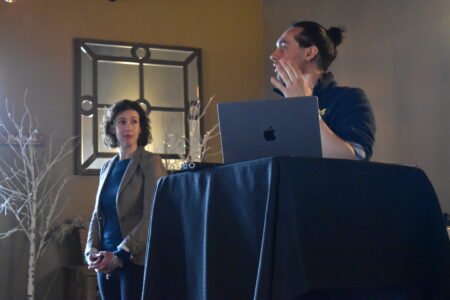Keweenaw Wild Bird R.E.C. rehabilitates injured UP birds

Photo provided by Michelle Anderson / This is a mallard duckling Keweenaw Wild Bird R.E.C. cared for over this past summer.
HOUGHTON — The Upper Peninsula has a great diversity of native bird life, from year-round residents like the black-capped chickadee, to migratory species like the ruby-throated hummingbird.
But sometimes, our feathered neighbors get into trouble. Maybe a blue jay has collided with your window or a baby songbird has fallen from its nest. If you find yourself wondering what to do with an injured or lost bird, Michelle Anderson is the person to call.
Anderson is a licensed bird rehabilitator who recently launched Keweenaw Wild Bird R.E.C., a nonprofit with a mission of providing wildlife rehabilitation to sick, injured, and orphaned native wild birds in the Keweenaw Peninsula.
“What we do is take calls from the public, they’ll call if there’s a sick, injured or orphaned bird,” Anderson explained during a phone conversation with the Gazette. “If they’re injured or truly orphaned or ill, we’ll have people bring the birds to us, or I’ll meet people and pick the bird up.”
Anderson has worked as a rehabber for 12 years and a veterinary technician for 25. After settling in the UP, she decided to start Keweenaw Wild Bird R.E.C. to focus on bird rehabilitation as well as conservation and education.
“My husband was in the Coast Guard for 21 years, so we lived all over the country. I worked in different places like in Key West and Napa, California and Alaska,” she explained. “Once we came here, we decided that we wanted to focus more specifically on the birds, and do a lot of school aged education and conservation.”
With the help of volunteers, Anderson rehabilitates injured birds in her barn, which has been converted into a bird hospital equipped with an incubator, heating lights, cages, an aviary, and lots of food for hungry birds.
The team cares for all species of native migratory birds, with the exception of raptors. Anderson estimated that she has treated about 100 birds this year, ranging from hummingbirds to waterfowl. She even took care of a sandhill crane.
“Most of what we see are passerines, which are basically perching birds. So hummingbirds up to crows and ravens. We get a lot of robins, a lot of waxwings, and a lot of woodpeckers,” Anderson said.
“We’ll get a few birds over the fall and winter, but most of our busy time is the migratory birds that are here in the summer,” she continued. “In the spring, we get a lot of window collisions, birds are coming through and don’t really know the area. There are times where I’ve admitted 10 birds in a day.”
Anderson treats all manner of bird injuries, from broken bones to cuts inflicted by cats. Volunteers help prepare food and feed the recovering birds.
Because Keweenaw Wild Bird R.E.C. releases its patients back into the wild, rehabbers try to ensure that the birds remain wild throughout the rehabilitation process. They limit the birds’ contact with people and give them foods that closely resemble their natural diet.
“Our job as wildlife rehabbers is to make it as wild an experience for them as possible,” Anderson explained. “So we don’t talk to them, we don’t cuddle with them. A lot of them are covered so they’re not looking at people.”
In addition to injuries, Keweenaw Wild Bird R.E.C. takes in orphaned baby birds.
“We get a lot of baby songbirds in the summer,” Anderson said. “I can have anywhere from 20 to 30 baby birds in our little bird clinic at a time, and those birds get fed from basically sunup to sundown every 10 to 20 minutes.”
Although winter is generally a less busy time, Anderson and her team are currently taking care of two patients: a dove who hit a window, and a pileated woodpecker who was struck by a car.
“The woodpecker I have now, she was hit by a car and she has a spinal injury,” Anderson said. “She’s on several medications, like anti inflammatories, and then she also went for laser therapy at the vet, which actually can help reduce inflammation.”
Sadly, Anderson reported that the majority of the bird maladies that she treats are the result of human activity.
“Really, the reason I do it is to try to counteract all of the negative things that humans are doing to birds,” she said. “I feel like it’s my duty to try to help those that are affected primarily by humans. But it’s a labor of love. I really enjoy it,” she continued. “If I can make a difference, and hopefully make for a better future for wild birds, my job is done.”
Anderson’s advice for someone who comes across an injured bird is to call Keweenaw Wild Bird R.E.C. before approaching.
“I like people to talk to me before they do anything, just to make sure because some birds are dangerous,” she advised. “So I always encourage people to call, and if they can snap a picture or take a video, then I can see what the bird is doing.”
Keweenaw Wild Bird R.E.C. can be reached at (906) 299-2149 or keweenawwildbirdrec@gmail.com. They also have Facebook and Instagram pages containing more information and pictures of recuperating birds. The group welcomes financial donations and volunteers.




